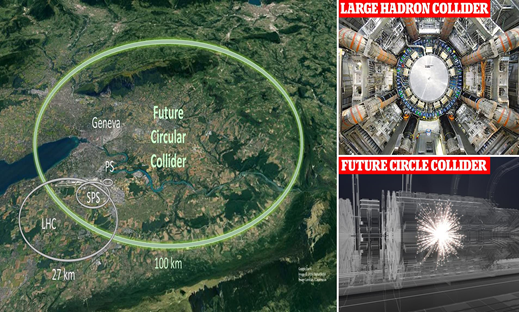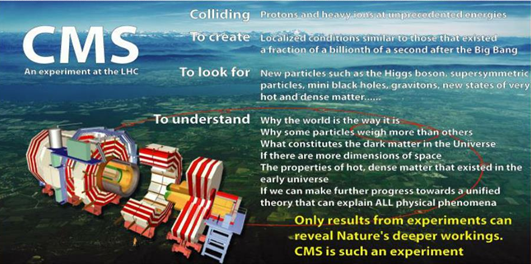

5th July 2022 (7 Topics)
Context
The world’s most powerful particle collider, the Large Hadron Collider (LHC), will begin smashing protons into each other at unprecedented levels of energy.
About
About Large Hadron Collider:
- The Large Hadron Collider is a giant, complex machine built to study particles that are the smallest known building blocks of all things.
- Structurally, the LHC is a 27-km-long track-loop buried 100m underground on the Swiss-French border.
- In its operational state, it fires two beams of protons almost at the speed of light in opposite directions inside a ring of superconducting electromagnets.
- The magnetic field created by the superconducting electromagnets keeps the protons in a tight beam and guides them along the way as they travel through beam pipes and finally collide.
- Just prior to collision, another type of magnet is used to ‘squeeze’ the particles closer together to increase the chances of collisions.
- Since the LHC’s powerful electromagnets carry almost as much current as a bolt of lightning, they must be kept chilled.
- The LHC uses a distribution system of liquid helium to keep its critical components ultracold at minus 271.3 degrees Celsius, which is colder than interstellar space.

Large Hadron Collider Previous Runs:
- LHC’s first run:
-
- Ten years ago, on July 4, 2012, scientists at CERN had announced to the world the discovery of the Higgs boson or the ‘God Particle’.
- The discovery concluded the decades-long quest for the ‘force-carrying’ subatomic particle, and proved the existence of the Higgs mechanism, a theory put forth in the mid-sixties.
- This led to Peter Higgs and his collaborator François Englert being awarded the Nobel Prize for physics in 2013.
- LHC’s second run: It began in 2015 and lasted till 2018. The second season of data taking produced five times more data than Run 1.
- LHC’s third run: It is expected to see 20 times more collisions as compared to Run 1.
-
- It will operate round-the-clock for four years at unprecedented energy levels of 13 tera electron volts.
- A TeV is 100 billion, or 10-to-the-power-of-12, electon volts.
- An electron volt is the energy given to an electron by accelerating it through 1 volt of electric potential difference.
- For the ATLAS and CMS experiments, scientists aim to be delivering 1.6 billion proton-proton collisions per second. The proton beams will be narrowed to less than 10 microns — a human hair is around 70 microns thick — to increase the collision rate.
- It will operate round-the-clock for four years at unprecedented energy levels of 13 tera electron volts.
ATLAS:
- ATLAS is one of two general-purpose detectors at the Large Hadron Collider (LHC).
- It investigates a wide range of physics, from the search for the Higgs boson to extra dimensions and particles that could make up dark matter.
- Although it has the same scientific goals as the CMS experiment, it uses different technical solutions and a different magnet-system design.
- Beams of particles from the LHC collide at the centre of the ATLAS detector making collision debris in the form of new particles, which fly out from the collision point in all directions.
- Six different detecting subsystems arranged in layers around the collision point record the paths, momentum, and energy of the particles, allowing them to be individually identified.
- A huge magnet system bends the paths of charged particles so that their momenta can be measured.

Compact Muon Solenoid (CMS):
- The Compact Muon Solenoid (CMS) is a general-purpose detector at the Large Hadron Collider (LHC).
- It has a broad physics programme ranging from studying the Standard Model (including the Higgs boson) to searching for extra dimensions and particles that could make up dark matter.
- Although it has the same scientific goals as the ATLAS experiment, it uses different technical solutions and a different magnet-system design.
- The CMS detector is built around a huge solenoid magnet.
- This takes the form of a cylindrical coil of superconducting cable that generates a field of 4 tesla, about 100,000 times the magnetic field of the Earth.

More Articles



